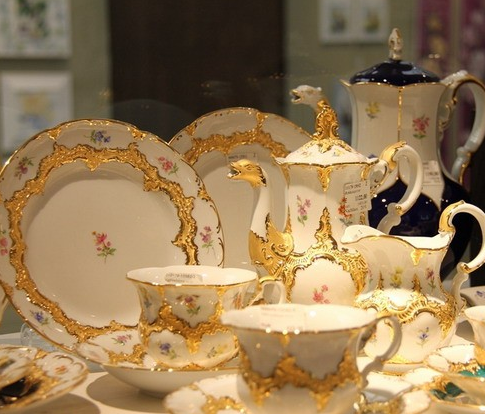Good afternoon ladies and gentlemen
先生們 女士們 下午好
and thank you, Andrea
安德莉亞
for such a nice introduction
謝謝你給我們帶來如此精彩的介紹
This beautiful exhibition explores 150 exceptional paintings
這個華麗的展覽探索了150件無與倫比的畫作
and art objects which were created to celebrate
和藝術品 這些作品是為了慶祝
love and marriage in the Italian Renaissance
意大利文藝復興時期的愛情和婚姻觀
Among these are a large group of ceramics
其中有大批瓷器
which through either iconography or inscriptions
要么通過圖像 要么通過文字
explore the theme of the exhibition
來探索該展覽的主題

in sometimes surprising ways
有時候還會以不可思議的方式來呈現
One of the impressive features of the exhibition is that
本次展覽一個令人印象深刻的特征就是
it introduces to a general audience
它向大眾展示了不同媒介
such a wide of material
所呈現出來的廣泛內容
in different media from ceramics to prints and jewelry
從陶瓷到版畫和珠寶
and shows this alongside some of
同時也展示了文藝復興時期
the most famous Renaissance Paintings
最著名的繪畫作品
In introducing the ceramics to you, I will focus on what the pieces
在向你們介紹瓷器之前 我將重點講解
themselves have to tell us about
那些將告訴我們其社會背景
their social and intellectual context
和知識背景的展品
This means looking in detail at their imagery and inscriptions
這意味著我們要細致地觀察它們的圖像和文字
as a way of exploring the status and significance
以此作為探索這些瓷器
which these ceramics originally had
對意大利文藝復興時期的原主人
for their Italian Renaissance owners
所擁有的地位和意義
During the fifty year period, 1475-1525
在1475-1525年的50年間
Italian potters developed a revolutionary new ceramic
當時的意大利制陶工人發明了一種革新的瓷器
a kind of tin glazed pottery, maiolica
那是一種錫釉陶器 叫做馬爵利卡陶瓷
which astonished contemporaries for its fineness and lightness
其成色和亮度 明亮的顏色
its brilliant pigments, glossy glazes and its white clean surface
釉面光澤度及其干凈的外觀讓當代人震驚不已
Maiolica was no minor art-form
馬爵利卡陶瓷并非文藝復興時期
during the renaissance
較為次要的藝術形式
It's the principle branch of renaissance art
相反 它是文藝復興時期藝術的主流
that has preserved its original colouring
它完整地保留了其原本的色彩
As an index of taste
作為一種試驗指標
it offers a wide range of non-religious subject matter
它涉及廣泛的非宗教主題素材
and as a form of ceramics
而作為陶瓷的一種形式
it came closer to
自古希臘時期
the art of painting than at any time
開始生產繪有人物畫像的陶器以來
since the production of figured pottery in Ancient Greece
它和繪畫藝術的結合比任何時期都更為緊密
To illustrate some of these points
為了說明這幾點
here is a delightful dish
這是一個很討喜的盤子
painted and lustered in Gudya
在古地亞完成彩繪和上釉的工序
in around 1524-7
這大概是1524-1527年間的事
with an erotic scene in a landscape
上面的情境中還有情色畫面
The young lovers, oblivious to all the activity around them
這對小情侶對身邊所發生的事物渾然不覺
may be the honeymooning couple
正在親熱的那一對或許正是當代詩人
Angelica and Medoro from a contemporary poem
阿里奧斯托的長詩《瘋狂奧蘭多》中
Ariosto's "Orlando Furioso"
描繪的安吉利卡和米多洛
The lyrical painting style echoes that of Raphael
這種抒情畫風格和拉斐爾的繪畫風格遙相呼應
and the dish has in the past been attributed to
過去 這個盤子被認為
Nicola da Urbino
是屬于尼科拉·德?烏爾比諾的
often known as the Raphael of maiolica painters
通常他被認為是馬爵利卡陶瓷畫師界的拉斐爾
As the sixteenth century painter and art critics
作為16世紀的畫家和藝術評論家
Giorgio Vasari pointed out
喬治·凡塞爾指出
the brightly coloured narratives of
像這樣帶有鮮明敘事體的
escoriato maiolica like this
馬爵利卡陶瓷完成品
was something not even
即便是古希臘和古羅馬
the ancient Greeks and Romans had achieved
也是無法企及的
rivaling the art of the ancients was something
和古代藝術相比
that lay at the heart of
那是深藏于意大利文藝復興時期
Italian Renaissance culture
文化中心的事物











